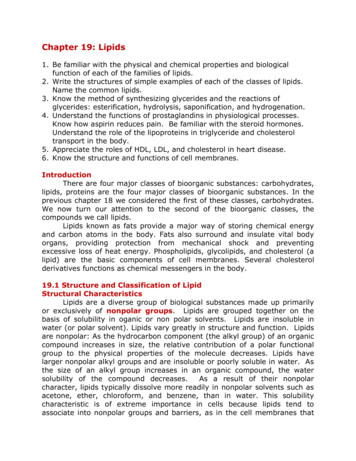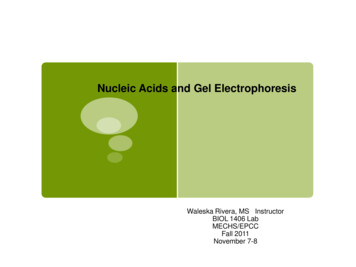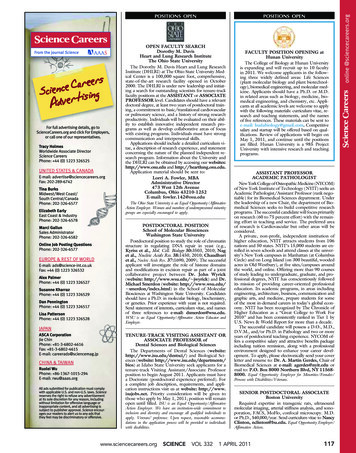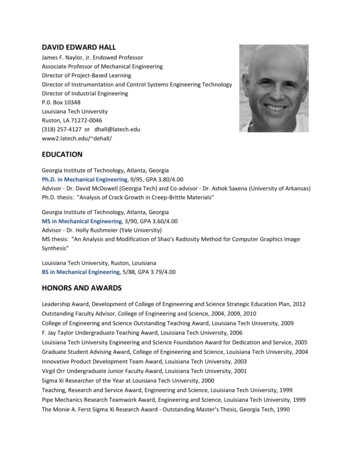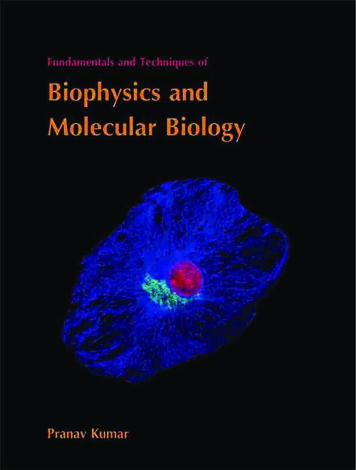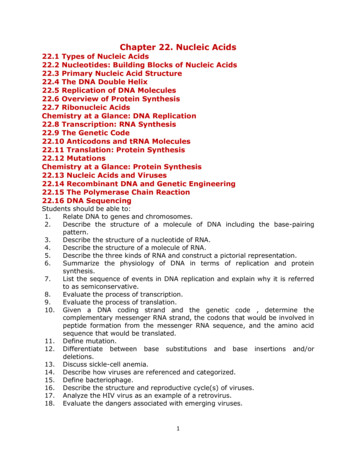
Transcription
Chapter 22. Nucleic Acids22.1 Types of Nucleic Acids22.2 Nucleotides: Building Blocks of Nucleic Acids22.3 Primary Nucleic Acid Structure22.4 The DNA Double Helix22.5 Replication of DNA Molecules22.6 Overview of Protein Synthesis22.7 Ribonucleic AcidsChemistry at a Glance: DNA Replication22.8 Transcription: RNA Synthesis22.9 The Genetic Code22.10 Anticodons and tRNA Molecules22.11 Translation: Protein Synthesis22.12 MutationsChemistry at a Glance: Protein Synthesis22.13 Nucleic Acids and Viruses22.14 Recombinant DNA and Genetic Engineering22.15 The Polymerase Chain Reaction22.16 DNA SequencingStudents should be able to:1.Relate DNA to genes and chromosomes.2.Describe the structure of a molecule of DNA including the base-pairingpattern.3.Describe the structure of a nucleotide of RNA.4.Describe the structure of a molecule of RNA.5.Describe the three kinds of RNA and construct a pictorial representation.6.Summarize the physiology of DNA in terms of replication and proteinsynthesis.7.List the sequence of events in DNA replication and explain why it is referredto as semiconservative.8.Evaluate the process of transcription.9.Evaluate the process of translation.10. Given a DNA coding strand and the genetic code , determine thecomplementary messenger RNA strand, the codons that would be involved inpeptide formation from the messenger RNA sequence, and the amino acidsequence that would be translated.11. Define mutation.12. Differentiate between base substitutions and base insertions and/ordeletions.13. Discuss sickle-cell anemia.14. Describe how viruses are referenced and categorized.15. Define bacteriophage.16. Describe the structure and reproductive cycle(s) of viruses.17. Analyze the HIV virus as an example of a retrovirus.18. Evaluate the dangers associated with emerging viruses.1
22.6 Overview of Protein Synthesis22.7 Ribonucleic AcidsChemistry at a Glance: DNA Replication22.8 Transcription: RNA Synthesis22.9 The Genetic Code22.10 Anticodons and tRNA Molecules22.11 Translation: Protein Synthesis22.12 MutationsChemistry at a Glance: Protein Synthesis22.13 Nucleic Acids and Viruses22.14 Recombinant DNA and Genetic Engineering22.15 The Polymerase Chain Reaction22.16 DNA SequencingIntroductionA most remarkable property of living cells is their ability to produce exactreplicas of themselves. This is due to the cells containing fact that all theinstructions needed for making the complete organism of which they are apart. Nucleic acids are the molecules within a cell that are responsible forthese amazing capabilities.The first isolation of nucleic acid we now refer to as DNA was accomplishedby Swiss physiologist Johann Friedrich Miescher circa 1870 while studyingthe nuclei of white blood cells. In the 1920's nucleic acids were found to bemajor components of chromosomes, small gene-carrying bodies in the nucleiof complex cells. Elemental analysis of nucleic acids showed the presence ofphosphorus, in addition to the usual C, H, N & O. We now know that nucleicacids are found throughout a cell, not just in the nucleus, the name nucleicacid is still used for such materials.A nucleic acid is a polymer in which the monomer units are nucleotides.There are two Types of Nucleic Acids:DNA: Deoxyribonucleic Acid: Found within cell nucleus for storing andtransfering of genetic information that are passed from one cell to otherduring cell divisionRNA: Ribonucleic Acid: Occurs in all parts of cell serving the primaryfunction is to synthesize the proteins needed for cell functions.22.1 Types of Nucleic AcidsThe nucleic acids are very large molecules that have two main parts. Thebackbone of a nucleic acid is made of alternating sugar and phosphatemolecules bonded together in a long chain, represented below:2
sugarphosphatesugarphosphate .Each of the sugar groups in the backbone is attached (via the bond shown inred) to a third type of molecule called a nucleotide base. There are only fourdifferent nucleotide bases can occur in a nucleic acid and are classified aspyrimidine or purine bases:Though only four different nucleotide bases can occur in a nucleic acid, eachnucleic acid contains millions of bases bonded to it. The order in which thesenucleotide bases appear in the nucleic acid is the coding for the informationcarried in the molecule. In other words, the nucleotide bases serve as a sortof genetic alphabet on which the structure of each protein in our bodies isencoded.3
DNAIn most living organisms (except for viruses), genetic information is storedin the molecule deoxyribonucleic acid, or DNA. DNA is made and resides inthe nucleus of living cells. DNA gets its name from the sugar moleculecontained in its backbone(deoxyribose); however, it gets its significancefrom its unique structure. Four different nucleotide bases occur in DNA:adenine (A), cytosine (C), guanine (G), and thymine (T).22.2 Nucleotides: Building Blocks of Nucleic AcidsNames of DNA dine2'-Deoxythymidine-5'-monophosphateRNA has the same nucleotide srtuctiure except the thymine base is replacesby uracil.22.3 Primary Nucleic Acid StructurePolynucleotidesIn polynucleotides, nucleotides are joined to one another by covalent bondsbetween the phosphate of one and the sugar of another. These linkages arecalled phosphodiester linkages. This nucleic acids found in the cell haveprimary structures that arise from the end-to-endl polymerization of singlenucleotide units. The links between each nucleotide are formed byesterification reactions between the sugar's C3′ hydroxyl group and the phosphate of an incoming nucleoside triphosphate (NTP) to form aphosphoester linkage.The sugar is ribose in the case of RNA, deoxyribose in DNA. Thispolymerization process leaves a free hydroxyl on the incoming nucleotide (onthe 3′ C of the sugar) to serve for the next reaction in chain elongation.22.4 The DNA Double Helix4
The 1962 Nobel Prize in Physiology or Medicine was awarded to Crick,Watson and Wilkins for the discovery of the molecular structure of DNA –the double helix.Chemical Structure of the DNA double strandsDNA (deoxyribonucleic acid) is a double-stranded molecule that is twistedinto a helix like a spiral staircase. Each strand is comprised of a sugarphosphate backbone and numerous base chemicals attached in pairs.The four bases that make up the stairs in the spiraling staircase are adenine(A), thymine (T), cytosine (C) and guanine (G). These stairs act as the"letters" in the genetic alphabet, combining into complex sequences to formthe words, sentences and paragraphs that act as instructions to guide theformation and functioning of the host cell. Maybe even more appropriately,the A, T, C and G in the genetic code of the DNA molecule can be comparedto the "0" and "1" in the binary code of computer software. Like software toa computer, the DNA code is a genetic language that communicatesinformation to the organic cell.Genetic codeThe DNA code, like a floppy disk of binary code, is quite simple in its basicpaired structure. However, it's the sequencing and functioning of that codethat's enormously complex. Through recent technologies like x-raycrystallography, we now know that the cell is not a "blob of protoplasm", but5
rather a microscopic marvel that is more complex than the space shuttle.The cell is very complicated, using vast numbers of phenomenally preciseDNA instructions to control its every function.22.5 Replication of DNA MoleculesBefore a cell divides, its DNA is replicated (duplicated.) Because thetwo strands of a DNA molecule have complementary base pairs, thenucleotide sequence of each strand automatically supplies the informationneeded to produce its partner. If the two strands of a DNA molecule areseparated, each can be used as a pattern or template to produce acomplementary strand. Each template and its new complement togetherthen form a new DNA double helix, identical to the original.Before replication can occur, the length of the DNA double helix aboutto be copied must be unwound. In addition, the two strands must beseparated, much like the two sides of a zipper, by breaking the weakhydrogen bonds that link the paired bases. Once the DNA strands havebeen unwound, they must be held apart to expose the bases so that newnucleotide partners can hydrogen-bond to them.The enzyme DNA polymerase then moves along the exposed DNAstrand, joining newly arrived nucleotides into a new DNA strand that iscomplementary to the template.Each cell contains a family of more than thirty enzymes to insure theaccurate replication of DNA.6
22.6 Overview of Protein SynthesisDNA code: containing specific base code is used to create a specificpolypepetide-the protein containing a certain sequence of amino acids.The genetic code present in the DNA and later transcribed into mRNAconsists of 64 triplets of nucleotides. These triplets are calledcodons.With three exceptions, each codon encodes for one of the 20 aminoacids used in the synthesis of proteins. That produces some redundancy inthe code: most of the amino acids being encoded by more than one codon.RNA polymerase: RNA polymerases are enzyme complexes that synthesizemRNA molecules using DNA as a template, in the process known astranscription.Protein snthesis can be divided into two parts:1. TranscriptionBefore the synthesis of a protein begins, the corresponding RNA molecule isproduced by RNA transcription. One strand of the DNA double helix is usedas a template by the RNA polymerase to synthesize a messenger RNA(mRNA). This mRNA migrates from the nucleus to the cytoplasm. Duringthis step, mRNA goes through different types of maturation including one7
called splicing when the non-coding sequences are eliminated. The codingmRNA sequence can be described as a unit of three nucleotides called acodon.2. TranslationThe ribosome binds to the mRNA at the start codon (AUG) that isrecognized only by the initiator tRNA. The ribosome proceeds to theelongation phase of protein synthesis. During this stage, complexes,composed of an amino acid linked to tRNA, sequentially bind to theappropriate codon in mRNA by forming complementary base pairs with thetRNA anticodon. The ribosome moves from codon to codon along themRNA. Amino acids are added one by one, translated into polypeptidicsequences dictated by DNA and represented by mRNA. At the end, a releasefactor binds to the stop codon, terminating translation and releasing thecomplete polypeptide from the ribosome.One specific amino acid can correspond to more than one codon. The geneticcode is said to be degenerate.22.7 Ribonucleic AcidsOne of the two main types of nucleic acid (the other being DNA), whichfunctions in cellular protein synthesis in all living cells. Like DNA, it consistsof strands of repeating nucleotides joined in chainlike fashion, but thestrands are single and it has the nucleotide uracil (U) where DNA hasthymine (T).Messenger RNAWhereas most types of RNA are the final products of their genes, mRNA isan intermediate in information transfer. It carries information from DNA tothe ribosome in a genetic code that the protein-synthesizing machinerytranslates into protein. Specifically, mRNA sequence is recognized in a8
sequential fashion as a series of nucleotide triplets by tRNAs via base pairingto the three-nucleotide anticodons in the tRNAs. There are specific tripletcodons that specify the beginning and end of the protein-coding sequence.Thus, the function of mRNA involves the reading of its primary nucleotidesequence, rather than the activity of its overall structure. Messenger RNAsare typically shorter-lived than the more stable structural RNAs, such astRNA and rRNA. See Genetic codeSmall nuclear RNASmall RNAs, generally less than 300 nucleotides long and rich in uridine (U),are localized in the nucleoplasm (snRNAs) and nucleolus (snoRNAs) ofeukaryotic cells. There they take part in RNA processing, such as intronremoval during eukaryotic mRNA splicing and posttranscriptionalmodification that occurs during production of mature rRNA. See IntronCatalytic RNARNA enzymes, or ribozymes, are able to catalyze specific cleavage or joiningreactions either in themselves or in other molecules of nucleic acid. SeeCatalysis, Ribozyme22.8 Transcription: RNA SynthesisTranscription is the process of creating an equivalent RNA copy of asequence of DNA in double helix. Both RNA and DNA have base pairs ofnucleotides as a complementary language that can be converted back andforth from DNA to RNA in the presence of the correct enzymes, RNApolymerase. During transcription, a DNA sequence is read by RNApolymerase, which produces a complementary, antiparallel RNA strand. Asopposed to DNA replication, transcription results in an RNA complement thatincludes uracil (U) in all instances where thymine (T) would have occurred ina DNA complement.Transcription is the first step leading to gene expression. The stretchof DNA transcribed into an RNA molecule is called a transcription unit andencodes at least one gene. If the gene transcribed encodes for a protein, theresult of transcription is messenger RNA (mRNA), which will then be used tocreate that protein via the process of translation. Alternatively, thetranscribed gene may encode for either ribosomal RNA (rRNA) or transferRNA (tRNA), other components of the protein-assembly process, or otherribozymes.A DNA transcription unit encoding for a protein contains not only thesequence that will eventually be directly translated into the protein (thecoding sequence) but also regulatory sequences that direct and regulate thesynthesis of that protein. The regulatory sequence before (upstream from)the coding sequence is called the five prime untranslated region (5'UTR),and the sequence following (downstream from) the coding sequence is calledthe three prime untranslated region (3'UTR).9
Transcription has some proofreading mechanisms, but they are fewer andless effective than the controls for copying DNA; therefore, transcription hasa lower copying fidelity than DNA replication.As in DNA replication, DNA is read from 3' 5' during transcription.Meanwhile, the complementary RNA is created from the 5' 3' direction.Although DNA is arranged as two antiparallel strands in a double helix, onlyone of the two DNA strands, called the template strand, is used fortranscription. This is because RNA is only single-stranded, as opposed todouble-stranded DNA. The other DNA strand is called the coding strand,because its sequence is the same as the newly created RNA transcript(except for the substitution of uracil for thymine). The use of only the 3' 5' strand eliminates the need for the Okazaki fragments seen in DNAreplication.Transcription is divided into 5 stages: pre-initiation, initiation,promoter clearance, elongation and termination.Splicing of mRNA: Splicing is a modification of an RNA after transcription,in which introns (nonessential part opf the code)are removed andexons(essential part opf the code) are joined. Also tThe UTRs, non-codingparts of exons at the ends of the mRNA is also removed.Codon: The code is defined as a mapping of three-nucleotide basesequences and the amino acids. A triplet codon in a nucleic acid sequenceusually specifies a single amino acid (though in some cases the same codontriplet in different locations can code unambiguously for two different aminoacids.10
22.9 The Genetic CodeDNA code: containing specific base code to create a specific polypepetidethe protein containing a certain sequence of amino acids.The genetic code consists of 64 triplets of nucleotides. These triplets arecalled codons.With three exceptions, each codon encodes for one of the 20amino acids used in the synthesis of proteins. That produces someredundancy in the code: most of the amino acids being encoded by morethan one codon.One codon, AUG serves two related functions: it signals the start of translationit codes for the incorporation of the amino acid methionine (Met) intothe growing polypeptide chainThe genetic code can be expressed as either RNA codons or DNA codons.RNA codons occur in messenger RNA (mRNA) and are the codons that areactually "read" during the synthesis of polypeptides during translation. Buteach mRNA molecule acquires its sequence of nucleotides by transcriptionfrom the corresponding gene. Because DNA sequencing has become so rapidand because most genes are now being discovered at the level of DNAbefore they are discovered as mRNA or as a protein product, it is extremelyuseful to have a table of codons expressed as DNA. So here are both.Note that for each table, the left-hand column gives the first nucleotide ofthe codon, the 4 middle columns give the second nucleotide, and the lastcolumn gives the third nucleotide.The RNA CodonsSecond nucleotideUCAGUUU Phenylalanine UCU Serine(Phe)(Ser)UAU Tyrosine(Tyr)UGU Cysteine(Cys)UUUC PheUCC SerUAC TyrUGC CysCUCA SerUAA STOPUGA STOPAUCG SerUAG STOPUGGTryptophan(Trp)GCCU Proline(Pro)CAU Histidine(His)CGU Arginine(Arg)UU UUA Leucine (Leu)UUG LeuC CUU Leucine (Leu)11
AGCUC LeuCCC ProCAC HisCGC ArgCCUA LeuCCA ProCAA GlutamineCGA Arg(Gln)ACUG LeuCCG ProCAG GlnCGG ArgGACUAUU Isoleucine (Ile) Threonine(Thr)AAUAsparagine(Asn)AGU Serine(Ser)UAUC IleACC ThrAAC AsnAGC SerCAUA IleACA ThrAAA Lysine(Lys)AGA Arginine(Arg)AAUG Methionine(Met) or STARTACG ThrAAG LysAGG ArgGGUU Valine ValGCU Alanine(Ala)GAU Asparticacid (Asp)GGU Glycine(Gly)UGUC (Val)GCC AlaGAC AspGGC GlyCGUA ValGCA AlaGAA Glutamicacid (Glu)GGA GlyAGUG ValGCG AlaGAG GluGGG GlyGGenome:the genome is the entirety of an organism's hereditary information. It isencoded either in DNA or, for many types of virus, in RNA.The Human Genome Project - the entire human genome is currentlybeing decoded by labs around the world. The project, which started in 1990,aims to have the complete 3.2 billion base pair genome completed is a highquality form in 2003, at a final cost of over 3 billion dollars. Recently (1998)a private company, Celera Genomics, has amassed enough high speedautomated DNA sequencers and computing power (second only to thePentagon)22.10 Anticodons and tRNA MoleculesThese small RNAs (70–90 nucleotides) that act as adapters to translate thenucleotide sequence of mRNA into protein sequence. They do this bycarrying the appropriate amino acid to the ribosome during the process ofprotein synthesis. Each cell contains at least one type of tRNA specific foreach of the 20 amino acids, and usually several types. The base sequence inthe mRNA directs the appropriate amino acid-carrying tRNAs to the ribosometo ensure that the correct protein sequence is made.12
tRNA Secondary StructureThe translation process is fundamentally straightforward.The mRNA strand bearing the transcribed code forsynthesis of a protein interacts with relatively small RNAmolecules (about 70-nucleotides) to which individualamino acids have been attached by an ester bond at the3'-end. These transfer RNA's (tRNA) have distinctivethree-dimensional structures cosisting of loops of singlestranded RNA connected by double stranded segments.This cloverleaf secondary structure is further wrapped intoan "L-shaped" assembly, having the amino acid at the endof one arm, and a characteristic anti-codon region at theother end. The anti-codon consists of a nucleotide triplet that is thecomplement of the amino acid's codon(s). Models of two such tRNAmolecules are shown to the right. When read from the top to the bottom, theanti-codons depicted here should complement a codon in the previoustable.22.11 Translation: Protein SynthesisThis process involves following components:mRNA: Messenger RNA which is a single stranded copy of a DNA doublehelix base par sequence with uracil in the places where thyamine was.13
RibosomeRibosomes are the components of cells that make proteins from amino acids.Ribosomes then read the information in the mRNA and use the codond toproduce proteins.tRNA: The genetic code is read during translation using transfer-RNA,tRNAs that have 3-base anticodons complementary to codons in mRNA.The Steps of Translation1. Initiation The small subunit of the ribosome binds to a site "upstream" (on the5' side) of the start of the message.It proceeds downstream (5' - 3') until it encounters the start codonAUG. (The region between the cap and the AUG is known as the 5'untranslated region [5'-UTR].)Here it is joined by the large subunit and a special initiator tRNA.The initiator tRNA binds to the P site (shown in pink) on the ribosome.14
In eukaryotes, initiator tRNA carries methionine (Met). (Bacteria usea modified methionine designated fMet.)2. Elongation An aminoacyl-tRNA (a tRNAcovalently bound to its amino acid)able to base pair with the next codonon the mRNA arrives at the A site(green) associated with:o an elongation factor (calledEF-Tu in bacteria)o GTP (the source of the neededenergy)The preceding amino acid (Met at thestart of translation) is covalentlylinked to the incoming amino acidwith a peptide bond (shown in red).The initiator tRNA is released fromthe P site.The ribosome moves one codondownstream.This shifts the more recently-arrivedtRNA, with its attached peptide, tothe P site and opens the A site forthe arrival of a new aminoacyl-tRNA.This last step is promoted by anotherprotein elongation factor (calledEF-G in bacteria) and the energy of another molecule of GTP.Note: the initiator tRNA is the only member of the tRNA family that can binddirectly to the P site. The P site is so-named because, with the exception ofinitiator tRNA, it binds only to a peptidyl-tRNA molecule; that is, a tRNA withthe growing peptide attached.The A site is so-named because it binds only to the incoming aminoacyltRNA; that is the tRNA bringing the next amino acid. So, for example, thetRNA that brings Met into the interior of the polypeptide can bind only to theA site.15
3. Termination The end of translation occurs when the ribosome reaches one or moreSTOP codons (UAA, UAG, UGA). (The nucleotides from this point tothe poly(A) tail make up the 3'-untranslated region [3'-UTR] of themRNA.)There are no tRNA molecules with anticodons for STOP codons.However, protein release factors recognize these codons when theyarrive at the A site.Binding of these proteins —along with a molecule of GTP — releasesthe polypeptide from the ribosome.The ribosome splits into its subunits, which can later be reassembledfor another round of protein synthesis.22.12 MutationsA mutation is a permanent change in the DNA sequence of a gene or thegenetic code. Mutations in a gene's DNA sequence can alter the amino acidsequence of the protein encoded by the gene.How does this happen? Like words in a sentence, the DNA sequence of eachgene determines the amino acid sequence for the protein it encodes. TheDNA sequence is interpreted in groups of three nucleotide bases, calledcodons. Each codon specifies a single amino acid in a protein.Mutations can lead to changes in the structure of an encoded protein or to adecrease or complete loss in its expression. Because a change in the DNAsequence affects all copies of the encoded protein, mutations can beparticularly damaging to a cell or organism. In contrast, any alterations inthe sequences of RNA or protein molecules that occur during their synthesisare less serious because many copies of each RNA and protein aresynthesized.Geneticists often distinguish between the genotype and phenotype of anorganism. Strictly speaking, the entire set of genes carried by an individualis its genotype, whereas the function and physical appearance of anindividual is referred to as its phenotype.Chemistry at a Glance: Protein Synthesis22.13 Nucleic Acids and VirusesAll viruses have genes made from either DNA or RNA, long molecules thatcarry genetic information; all have a protein coat that protects these genes;16
and some have an envelope of fat that surrounds them when they areoutside a cell. Viroids do not have a protein coat and prions contain noRNA or DNA. Viruses vary from simple helical and icosahedral shapes, tomore complex structures. Most viruses are about one hundred times smallerthan an average bacterium. The origins of viruses in the evolutionary historyof life are unclear: some may have evolved from plasmids—pieces of DNAthat can move between cells—while others may have evolved from bacteria.In evolution, viruses are an important means of horizontal gene transfer,which increases genetic diversity.22.14 Recombinant DNA and Genetic Engineering1. Isolate Gene of InterestThe gene for producing a protein is isolated from a cell. The gene is on theDNA in a chromosome. Special DNA cutting proteins are used to cut outcertain sections of DNA. The gene can be isolated and then copied so thatmany genes are available to work with.2. Prepare Target DNAIn 1973, two scientists named Boyer and Cohen developed a way to put DNAfrom one organism into the DNA of bacteria. This process is calledrecombinant DNA technology. First, a circular piece of DNA called a plasmidis removed from a bacterial cell. Special proteins are used to cut the plasmidring to open it up.3. InsertDNA into PlasmidThe host DNA that produces the wanted protein is inserted into the openedplasmid DNA ring. Then special cell proteins help close the plasmid ring.17
4. Insert Plasmid back into cellThe circular plasmid DNA that now contains the host gene is inserted backinto a bacteria cell. The plasmid is a natural part of the bacteria cell. Thebacteria cell now has a gene in it that is from a different organism, evenfrom a human. This is what is called recombinant DNA technology5. Plasmid multipliesThe plasmid that was inserted into the bacteria cell can multiply to makeseveral copies of the wanted gene. Now the gene can be turned on in thecell to make proteins.6. Target Cells ReproduceMany recombined plasmids are inserted into many bacteria cells. While theylive, the bacteria's cell processes turn on the inserted gene and the proteinis produced in the cell. When the bacterial cells reproduce by dividing, theinserted gene is also reproduced in the newly created cells.7. Cells Produce ProteinsThe protein that is produced can be purified and used for a medicine,industrial, agricultural, or other uses. Check out the Uses section to see howGE is used.22.15 The Polymerase Chain ReactionThe polymerase chain reaction is a technique for quickly "cloning" aparticular piece of DNA in the test tube (rather than in living cells like E.coli). Thanks to this procedure, one can make virtually unlimited copies of asingle DNA molecule even though it is initially present in a mixturecontaining many different DNA molecules.The technique was made possible by the discovery of Taq polymerase, theDNA polymerase that is used by the bacterium Thermus auquaticus thatwas discovered in hot springs. This DNA polymerase is stable at the hightemperatures need to perform the amplification, whereas other DNApolymerases become denatured.Since this technique involves amplification of DNA, the most obviousapplication of the method is in the detection of minuscule amounts ofspecific DNAs. This important in the detection of low level bacterialinfections or rapid changes in transcription at the single cell level, as wellas the detection of a specific individual's DNA in forensic science (likein the O.J. trial). It can also be used in DNA sequencing, screening forgenetic disorders, site specific mutation of DNA, or cloning orsubcloning of cDNAs.There are three basic steps in PCR. First, the target genetic material must bedenatured-that is, the strands of its helix must be unwound and separated18
by heating to 90-96 C. The second step is hybridization or annealing, inwhich the primers bind to their complementary bases on the now singlestranded DNA. The third is DNA synthesis by a polymerase. Starting fromthe primer, the polymerase can read a template strand and match it withcomplementary nucleotides very quickly. The result is two new helixes inplace of the first, each composed of one of the original strands plus its newlyassembled complementary strand.All PCR really requires in the way of equipment is a reaction tube, reagents,and a source of heat. But different temperatures are optimal for each of thethree steps, so machines now control these temperature variationsautomatically.22.16 DNA SequencingDNA sequencing is the determination of the precise sequence of nucleotidesin a sample of DNA.19
The most popular method for doing this is called the dideoxy method orSanger method (named after its inventor, Frederick Sanger, who wasawarded the 1980 Nobel prize in chemistry [his second] for thisachievment).Replicating a DNA strand in the presence of dideoxy-TMOST of the time when a 'T' is required to make the new strand, the enzymewill get a good one and there's no problem. MOST of the time after adding aT, the enzyme will go ahead and add more nucleotides. However, 5% of thetime, the enzyme will get a dideoxy-T, and that strand can never again beelongated. It eventually breaks away from the enzyme, a dead end product.Sooner or later ALL of the copies will get terminated by a T, but each timethe enzyme makes a new strand, the place it gets stopped will be random.In millions of starts, there will be strands stopping at every possible T alongthe way.ALL of the strands we make started at one exact position. ALL of them endwith a T. There are billions of them . many millions at each possible Tposition. To find out where all the T's are in our newly synthesized strand, allwe have to do is find out the sizes of all the terminated products!20
Chemistry at a Glance: Protein Synthesis . backbone of a nucleic acid is made of alternating sugar and phosphate molecules bonded together in a long chain, represented below: 3 . information to the organic cell. Genetic code The DNA code, like a flo



